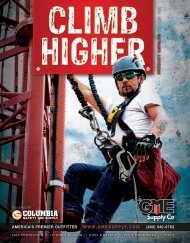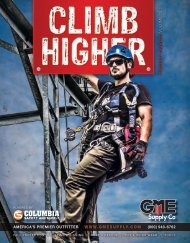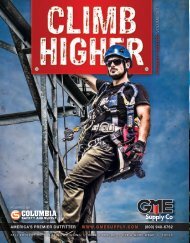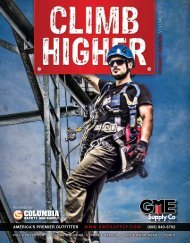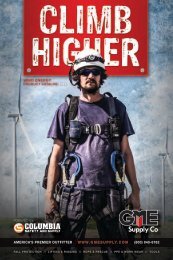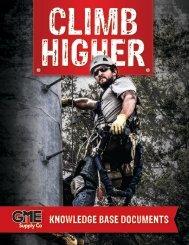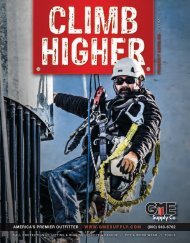GME Supply Catalog Version 19.4
GME Supply is North America's premier outfitter of fall protection, safety equipment, and gear for at-height workers, industry, and construction.
GME Supply is North America's premier outfitter of fall protection, safety equipment, and gear for at-height workers, industry, and construction.
Create successful ePaper yourself
Turn your PDF publications into a flip-book with our unique Google optimized e-Paper software.
UNDERSTANDING & CALCULATING FALL CLEARANCE REQUIREMENTS
FALL CLEARANCES 101
FREE FALL DISTANCE
Free fall is the distance covered before the fall
arrest device engages or catches you. This
distance varies for a couple reasons. Different
devices take longer than others to engage. Your
anchorage point also plays a part. See the 6 ft vs
12 ft free fall page for more information on this
topic (Page 27).
OVERHEAD ANCHOR POINT
CLASS A
SRL
2’
6’
CLASS B
SRL
4.5’
6’
6’ LANYARD
6’
4’
FOOT LEVEL ANCHOR POINT
LEADING
EDGE SRL
6’
3.5’
FOOT LEVEL
TIE-OFF
LANYARD
12’
Deceleration DISTANCE
This is the distance required to fully arrest the
fall. Once the device has caught, its energy
absorber will require time and distance to stop
you. Again, depending on the type of device, this
distance can be just a few inches to multiple feet.
HEIGHT OF DORSAL D-RING
This is the typical average height of the dorsal
D-Ring on a user’s full body harness measured
up from the walking working surface.
2’
2’
6’
6’
5’
HARNESS & D-RING SHIFT +
SAFETY FACTOR
This is the combined amount of harness webbing
elongation and dorsal D-Ring up-shift during the
entire fall event. It’s recommended to consider
this additional distance as a safety factor.
2’
2’
6’
SWING FALL
Swing fall occurs when your anchorage is not
directly above you. This hazard is typically most
associated with SRLs since you’re able to work
much farther from your anchorage point.
Fall clearance changes depending on anchorage
location. With a foot level anchor point, some
equipment requires more deceleration distance
to properly arrest the fall. Learn more about
anchorage points on the 6 ft vs 12 ft free fall
page (Page 27).
2’
The device will stop a fall in the required
distance, but the worker may still swing a great
distance, similar to a pendulum. This potentially
puts obstacles, walls, or even the ground in the
path of the worker.
It is recommended to always work within a 30
degree safe zone from your anchor. If you must
work farther away than this 30 degree safe zone,
you must either transition to a different anchor, or
consider using a mobile anchor, such as a beam
slider (Page 45).
REGULATIONS
OSHA 1910.140
1910.140(c)(5)
Self-retracting lifelines and lanyards that automatically
limit free fall distance to 2 ft (0.61 m) or less.
1910.140(d)(1)(ii)
Personal fall arrest systems must bring the employee
to a complete stop and limit the maximum deceleration
distance the employee travels to 3.5 ft (1.1 m).
OSHA 1926.502
1926.502(d)(16)(iv)
Personal fall arrest systems, when stopping a fall,
shall bring an employee to a complete stop and limit
maximum deceleration distance an employee travels to
3.5 ft (1.07 m).
STANDARDS
ANSI Z359.13 - 2013
Personal Energy Absorbers &
Energy Absorbing Equipment
3.1.8.1
6 ft free fall personal energy absorbers shall have a
maximum deployment distance of 48 inches.
3.1.8.2
12 ft free fall personal energy absorbers shall have a
maximum deployment distance of 60 inches.
Always refer to manufacturer’s specifications. Proper
fall protection training is required before performing any
at-height work.
36
GMESUPPLY.COM










